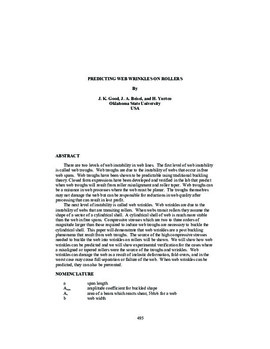| dc.contributor.author | Good, J. K. | |
| dc.contributor.author | Beisel, J. A. | |
| dc.contributor.author | Yurtcu, H. | |
| dc.contributor.other | International Conference on Web Handling (2009) | |
| dc.date.accessioned | 2019-11-11T19:52:47Z | |
| dc.date.available | 2019-11-11T19:52:47Z | |
| dc.date.issued | 2009-06 | |
| dc.identifier | oksd_icwh_2009_good | |
| dc.identifier.citation | Good, J. K., Beisel, J. A., & Yurtcu, H. (2009, June). Predicting web wrinkles on rollers. Paper presented at the Tenth International Conference on Web Handling (IWEB), Stillwater, OK. | |
| dc.identifier.uri | https://hdl.handle.net/11244/321965 | |
| dc.description.abstract | There are two levels of web instability in web lines. The first level of web instability is called web troughs. Web troughs are due to the instability of webs that occur in free web spans. Web troughs have been shown to be predictable using traditional buckling theory. Closed form expressions have been developed and verified in the lab that predict when web troughs will result from roller misalignment and roller taper. Web troughs can be a nuisance in web processes where the web must be planar. The troughs themselves may not damage the web but can be responsible for reductions in web quality after processing that can result in lost profit. | |
| dc.description.abstract | The next level of instability is called web wrinkles. Web wrinkles are due to the instability of webs that are transiting rollers. When webs transit rollers they assume the shape of a sector of a cylindrical shell. A cylindrical shell of web is much more stable than the web in free spans. Compressive stresses which are two to three orders of magnitude larger than those required to induce web troughs are necessary to buckle the cylindrical shell. This paper will demonstrate that web wrinkles are a post buckling phenomena that result from web troughs. The source of the high compressive stresses needed to buckle the web into wrinkles on rollers will be shown. We will show how web wrinkles can be predicted and we will show experimental verification for the cases where a misaligned or tapered rollers were the source of the troughs and wrinkles. Web wrinkles can damage the web as a result of inelastic deformation, fold-overs, and in the worst case may cause full separation or failure of the web. When web wrinkles can be predicted, they can also be prevented. | |
| dc.format | application/pdf | |
| dc.language | en_US | |
| dc.publisher | Oklahoma State University | |
| dc.rights | In the Oklahoma State University Library's institutional repository this paper is made available through the open access principles and the terms of agreement/consent between the author(s) and the publisher. The permission policy on the use, reproduction or distribution of the article falls under fair use for educational, scholarship, and research purposes. Contact Digital Resources and Discovery Services at lib-dls@okstate.edu or 405-744-9161 for further information. | |
| dc.title | Predicting web wrinkles on rollers | |
| osu.filename | oksd_icwh_2009_good.pdf | |
| dc.description.department | Mechanical and Aerospace Engineering | |
| dc.type.genre | Conference proceedings | |
| dc.type.material | Text | |
